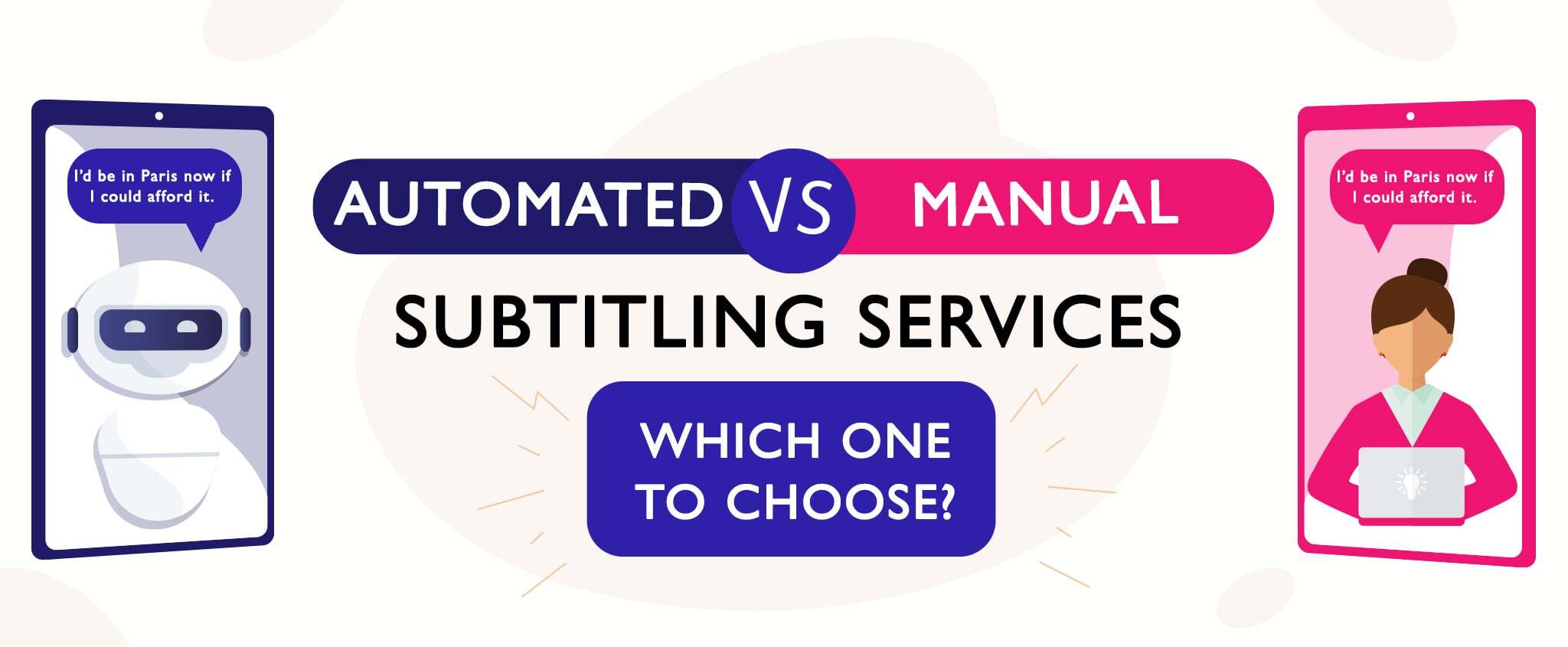Automated VS Manual Subtitling Services: Which One to Choose?
Producing materials for online video content has become a popular way to engage and inform audiences. After all, not everyone isn’t a fan of reading long articles! However, the challenge of sharing video content with a large audience is ensuring everyone understands. Eventually, you’ll have to rely on automated or manual subtitling services.
Subtitling helps you share your video content with multiple audiences, reaching target markets of different linguistic backgrounds. And thanks to technology, you have two options when talking about subtitling: manual and automated. Which one should you choose? CCCI International knows and has the answer!
Key Takeaways:
- Subtitling is an audiovisual aid for helping people of different linguistic backgrounds understand video content. It has helped many movies, shows, music, and businesses reach international audiences.
- Manual subtitling services involve human professionals who produce subtitles and manual captioning with quality and reliability. They’re more accurate and efficient but also more expensive and time-consuming than the other option.
- Automated subtitling heavily relies on technology. It’s a time-saving, cost-effective solution with fewer manual errors. However, there is a chance of translation errors, and it may still need manual intervention.
- Trusting a subtitling company helps businesses save time and money. Experts have the knowledge and experience to produce subtitles with quality, reliability, accuracy, and efficiency.
Table of Content:
- The Importance of Subtitling
- The Difference Between Automated and Manual Subtitling Services
- The Pros and Cons of Manual Subtitling
- The Pros and Cons of Automated Subtitling
- Why Should You Work with a Subtitling Company?
- CCCI – Professional Subtitling Services
The Importance of Subtitling
Subtitling is a type of text used in multimedia content that serves to translate a video or audio file into another language for better understanding. It’s an audiovisual translation practice that helps viewers consume information in any language. Subtitling has played a significant role in the last decade as it has helped content providers reach a larger audience worldwide.
Think of anime, for example. Subtitling allowed anime to go beyond its origin, Japan, and reach an international audience in the U.S., Europe, and other countries! Another excellent example is the rise of KDramas and KPop. Without subtitling, these forms of Korean entertainment wouldn’t have had the same impact internationally.
Note: 55% of Americans say it’s now harder to hear dialogues in shows and movies than before, so English materials also need subtitling! While English is one of the most spoken languages, subtitling still plays a crucial role in helping audiences better comprehend the content, regardless of their language.
For businesses that use video content as an integral part of their marketing strategy, subtitling is essential for success. Subtitling ensures your audience understands the message you’re trying to convey while improving user engagement. Globalization has become possible! Moreover, subtitles help with SEO rankings.
Subtitling can also be a form of customer support. Whatever products or services you provide, you can create subtitles for customer support videos or FAQs and make your brand more accessible to people in different languages. The more supported languages you provide, the better!
50% of Americans watch content with subtitles. Dubbing is also an option, but it’s not always effective. For example, some subtle nuances and mannerisms are difficult to convey in dubs. Many consumers also prefer to hear the original language as it brings authenticity. Subtitling helps you communicate accurately with a global audience across different language barriers.
The Difference Between Automated and Manual Subtitling Services
When you watch a video with subtitles, you won’t easily feel the process behind it. Listening to a language you don’t understand while reading the subtitles is much easier than trying to decipher the entire audio! Subtitling takes time, effort, and much labor, and the two main ways to do it are manually and automated.
Manual subtitling services involve manual labor. You manually transcribe, translate, and time the subtitles for accuracy. Automated subtitling, on the other hand, is done by software. It’s automating the process that removes manual labor and makes the task faster. Both require skill, accuracy, and precision, but manual subtitling requires more of them from translators.
Basically, you trust a human translator to ensure the message is accurately conveyed in manual captioning or subtitling. The other involves a machine’s AI learning and predicting what it hears. Which is better? Many will say it’ll always be manual subtitling. However, automated subtitling has improved significantly in recent years, making it a viable option.
Choosing either manual or automated services depends on your purpose, goal, and budget. Let’s look at the pros and cons of the two to better understand what you need.
The Pros and Cons of Manual Subtitling
There have been arguments and debates about manual subtitling, even among translators. Manual subtitling is done by real people with the necessary language skills and understanding of the text. Here are its pros and cons:
👍🏻 Pros
- High accuracy and precision
- Preservation of the speaker’s tone and voice
- Quality assurance by manual checking of the subtitles
👎🏻 Cons
- Expensive manual labor
- Time-consuming process
Manual subtitling is generally more accurate and reliable, as manual translators are more experienced than machines. It’s a human being communicating like a human being, for a human being!
The downside, however, is that it can be more expensive and time-consuming. Consider the manual labor involved, highlighting the skills and experiences of manual translators. Remember, the process involves the following phases and more:
🔹Spotting: Defining the in and out times of each subtitle to achieve synchronization with the audio
🔹Translation: Translating the subtitles into the desired language
🔹Correction: Checking the translation, grammar, spelling, punctuation, and overall flow of the dialogues
🔹Simulation: Watching the subtitles on the video to ensure they appear correctly
Pro tip: When choosing manual subtitling services, only work with experts. The quality of manual subtitling depends on how proficient the translators and editors are! Choose professionals who are native speakers, well-versed in the language, and have an eye for detail.
The Pros and Cons of Automated Subtitling
Automated subtitling has also been a topic of debate. It’s done by machines that automatically detect and transcribe audio from a video file. Here are its pros and cons:
👍🏻 Pros
- Cost-effective
- Easy to use and fast
- Ideal for subtitling large volumes of video content quickly
👎🏻 Cons
- More manual intervention is required to ensure the accuracy
- Lower accuracy and precision
This option is excellent if you want to provide subtitles for large volumes of videos quickly. However, you need manual intervention to ensure accuracy, as automated software may not pick up all the nuances in the audio.
The accuracy of the subtitles produced by software also depends on the quality of the audio or video file. If there’s noise, poor sound quality, or slang words in the audio, it may not produce the same quality as manual subtitling.
It’s also possible for the results to sound less natural than manual subtitling. A real person does not do it, so the tone and voice can be off. But overall, it’s much faster and cost-effective!
Why Should You Work with a Subtitling Company?
Let’s say you have the time to create subtitles for a video manually. Or you may have the money to acquire software to automate the process. But what about technical expertise and language skills? Doing the job yourself is an excellent option to save money, but working with a subtitling company can benefit you in the long run.
Subtitling companies have technical and language experts capable of producing high-quality manual and automated subtitles for various formats. They have the technical know-how and updated technologies! And If there’s a team you can trust 100% with subtitling, it’s CCCI.
CCCI – Professional Subtitling Services
As a professional translation and localization service provider, CCCI helps companies reach international customers by providing subtitling services for different industries in over 30 languages. Our team of experienced linguists, project managers, and technical experts handle both types of subtitling.
Our subtitling services involve translators and editors with native language proficiency to ensure accuracy, precision, and cultural appropriateness. No matter your goal, we guarantee you get the highest quality subtitles that keep your message’s impact.
CCCI has produced manga trailers, and we provide game translation and localization for gaming clients. Our portfolio includes corporate videos, feature films, TV series, and more! Our team knows the importance of subtitling and the advantages and disadvantages of automated and manual subtitling. With that knowledge, we’ll work with you to find the best solution for your project.
Give your international audience a chance to understand your message with subtitling services from CCCI. Contact us today to get started!




